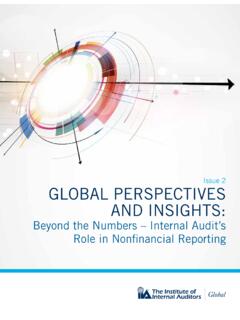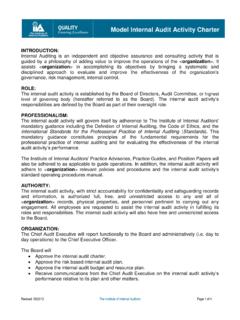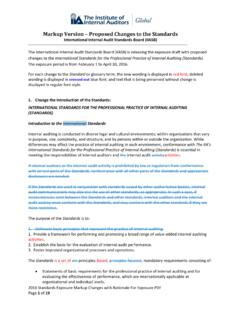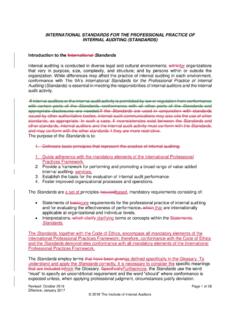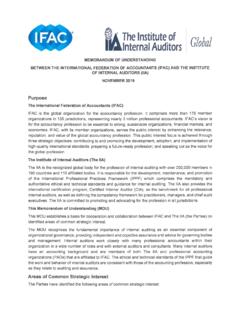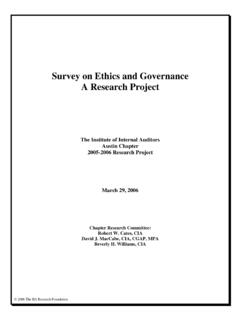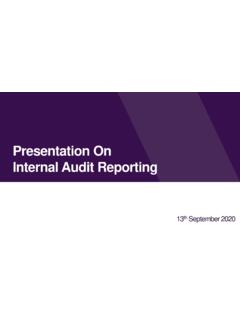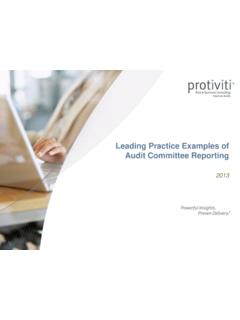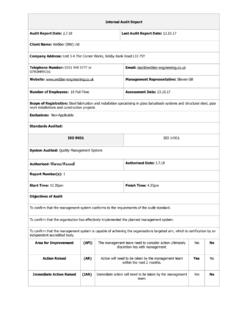Transcription of INTERNAL AUDIT’S ROLE IN ESG REPORTING
1 INTERNAL audit S ROLE IN ESG REPORTING Table of Contents 1 INTERNAL audit s role in ESG REPORTING .. 1 Introduction .. 2 Embarking on the ESG journey .. 2 Key considerations .. 3 Sound governance, control 3 INTERNAL control .. 3 Governance .. 4 INTERNAL audit s role in ESG REPORTING .. 5 REPORTING accuracy, consistency is critical .. 5 Assurance .. 5 Advisory .. 6 Growth in ESG REPORTING .. 7 Standards, regulations, and frameworks .. 7 Regulatory focus .. 7 Frameworks .. 8 Investor pressure .. 9 Conclusion ..10 ESG imperative, risk relevance growing ..10 Notes ..11 1 PURPOSE INTERNAL audit s role in ESG REPORTING Conversations and focus on sustainability, typically grouped into environmental, social and governance (ESG) issues, are quickly evolving from activist investor groups and inquisitive regulators pushing for change to governing bodies and C-suite executives struggling to understand and embrace the concept.
2 At the forefront of this new risk area is pressure for organizations to make public commitments to sustainability and provide routine updates to ESG-related strategies, goals, and metrics that are accurate and relevant. However, ESG REPORTING is still immature, and there is not a lot of definitive guidance for organizations in this space. For example, there is no single standard for what should be reported. What is clear is that strong governance over ESG as with effective governance overall requires alignment among the principal players as outlined in The IIA Three Lines Model. As with any risk area, INTERNAL audit should be well-positioned to support the governing body and management with objective assurance, insights, and advice on ESG matters.
3 The following provides an overview of risks related to ESG REPORTING along with context on the growing sustainability movement. It also outlines INTERNAL audit s role in ESG REPORTING and how INTERNAL audit can support ESG objectives and add value. 2 INTRODUCTION Embarking on the ESG journey Efforts to mitigate the accelerating effects of climate change and address perceived historical social inequities are two powerful issues driving change globally. These movements have enhanced awareness of how all organizations impact, influence, and interact with society and the environment. They also have spurred organizations to better recognize and manage ESG risks ( , risks associated with how organizations operate in respect to their impact on the world around them).
4 This broad risk category includes areas that are dynamic and often driven by factors that can be difficult to measure objectively, such as inclusion, ethical behavior, corporate culture, and embracing sustainability across the organization. Still, there is growing urgency for organizations to understand and manage ESG risks, particularly as investors and regulators focus on organizations producing high-quality REPORTING on sustainability efforts. What s more, that pressure is being reflected increasingly in executive performance as more organizations tie incentive compensation metrics to ESG goals. Additional risk areas associated with ESG are varied and can include reliance on third-party data, potential reputational damage from faulty REPORTING , and the real possibility that an organization s explicit commitments to meet specific sustainability goals could grow into a material weakness.
5 As ESG REPORTING becomes increasingly common, it should be treated with the same care as financial REPORTING . Organizations need to recognize that ESG REPORTING must be built on a strategically crafted system of INTERNAL controls and accurately reflect how an organization s ESG efforts relate to each other, the organization s finances, and value creation. INTERNAL audit can and should play a significant role in an organization s ESG journey. It can add value in an advisory capacity by helping to identify and establish a functional ESG control environment. It also can offer critical assurance support by providing an independent and objective review of the effectiveness of ESG risk assessments, responses, and controls.
6 Additionally, INTERNAL audit functions that operate in conformance with The IIA s globally recognized standards are well-positioned to help their organizations apply established, credible INTERNAL control frameworks to their ESG efforts. Seeking out objective assurance on all ESG-related risk management processes from a qualified, independent, and properly resourced INTERNAL audit function should be part of any ESG strategy. While this white paper outlines how and why INTERNAL audit should play a critical role in an organization s sustainability REPORTING efforts, it bears repeating that REPORTING comprises only part of an effective ESG strategy. INTERNAL audit should provide assurance and advice over all aspects of ESG risk management.
7 3 KEY CONSIDERATIONS Sound governance, control paramount The various drivers of increased sustainability REPORTING investor, regulatory, and social have created pressure for organizations to produce. However, without a reasoned ESG risk-management strategy built on a clear-eyed understanding of the issues, poorly executed sustainability reports can quickly run afoul of regulatory compliance and astray of investor expectations. To avoid such missteps, leadership should focus on effective INTERNAL control and governance over ESG matters. Each organization ultimately must identify and evaluate its top ESG impacts and determine goals to manage them. Target goals should be realistic and measurable because of the risk of not meeting them.
8 INTERNAL control INTERNAL control is a process, effected by an entity s governing body, management, and other personnel, designed to provide reasonable assurance regarding the achievement of objectives relating to operations, REPORTING , and Because ESG REPORTING can contain a wide variety of metrics, organizations must establish policies, processes, and INTERNAL controls that generate reliable information for decision-making and ensure the quality of data being produced and reported. Similar to financial REPORTING , the data used to create sustainability reports are based on the day-to-day operations and decisions driving organizations toward achieving objectives. Proper control activities must be designed and operating effectively from the operational steps to the collection and analysis of the data that will be used in REPORTING .
9 Operationalizing sufficient control activities is the responsibility of management, while INTERNAL audit is responsible for providing independent assurance that the activities are properly designed and operating effectively. What is ESG? Environmental, social, and governance (ESG) refers to criteria that characterize an organization s operations as sustainable, responsible, or ethical. Although there can be some overlap, ESG-related topics generally fall under one of the three main categories represented in its acronym: E: Environmental considers how an organization performs as a steward of nature. This can include issues related to carbon emissions, waste management, water management, raw material sourcing, and climate change vulnerability.
10 S: Social examines how organizations manage relationships with employees, customers, and the greater community. Risks that fall under this category can include corporate social responsibility, labor management, data privacy, general security, and health and safety. With the recent rise of high-profile movements related to addressing racial injustice, social ESG-related subjects such as diversity, equity, and inclusion have taken prominence. G: Governance refers to variables such as business ethics, leadership, executive pay, audits, INTERNAL controls, intellectual property protection, and shareholder rights. Diversity risks, while social in nature, also can fall under the governance umbrella, such as actions to improve board diversity.
